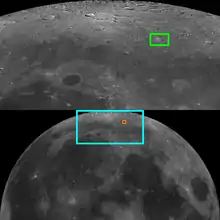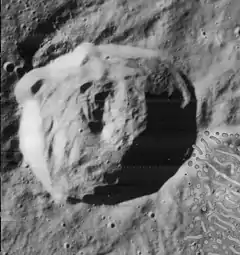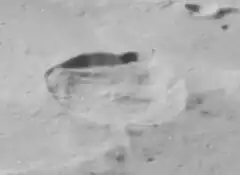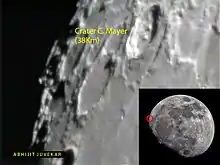C. Mayer (crater)
C. Mayer is a lunar impact crater that is located at the northern edge of the Mare Frigoris, due north of the prominent crater Aristoteles. Also to the south, but only a third as distant, is the smaller crater Sheepshanks. Due east of C. Mayer is the flooded crater Kane.
 Location of the crater C. Mayer | |
| Coordinates | 63.2°N 17.3°E |
|---|---|
| Diameter | 38 km |
| Depth | Unknown |
| Colongitude | 343° at sunrise |
| Eponym | Christian Mayer |


C. Mayer is a relatively young formation, with a sharp-edged and well-defined outer rim. The rim is not quite circular, and appears somewhat polygonal-shaped with outward bulges along the edge, most notably to the west. The inner walls have a terrace system and the interior is somewhat rough and irregular. The central peak lies just to the north of the midpoint, and extends in a northerly direction.
The lava-flooded formation C. Mayer D is attached to the southeastern rim of the crater, and a gap in the southeastern rim joins it to the Mare Frigoris. Thus the lunar mare extends up to the outer rampart of C. Mayer.

Satellite craters
By convention these features are identified on lunar maps by placing the letter on the side of the crater midpoint that is closest to C. Mayer (See the C Mayer D crater that is very similar in shape to the map of Brazil). >> [(pt:C. Mayer D (Cratera) )]
| C. Mayer | Latitude | Longitude | Diameter |
|---|---|---|---|
| B | 60.2° N | 15.6° E | 36 km |
| D | 62.1° N | 18.6° E | 66 km |
| E | 61.1° N | 16.0° E | 12 km |
| F | 62.0° N | 19.5° E | 7 km |
| H | 64.1° N | 14.7° E | 43 km |
References
- Andersson, L. E.; Whitaker, E. A. (1982). NASA Catalogue of Lunar Nomenclature. NASA RP-1097.
- Blue, Jennifer (July 25, 2007). "Gazetteer of Planetary Nomenclature". USGS. Retrieved 2007-08-05.
- Bussey, B.; Spudis, P. (2004). The Clementine Atlas of the Moon. New York: Cambridge University Press. ISBN 978-0-521-81528-4.
- Cocks, Elijah E.; Cocks, Josiah C. (1995). Who's Who on the Moon: A Biographical Dictionary of Lunar Nomenclature. Tudor Publishers. ISBN 978-0-936389-27-1.
- McDowell, Jonathan (July 15, 2007). "Lunar Nomenclature". Jonathan's Space Report. Retrieved 2007-10-24.
- Menzel, D. H.; Minnaert, M.; Levin, B.; Dollfus, A.; Bell, B. (1971). "Report on Lunar Nomenclature by the Working Group of Commission 17 of the IAU". Space Science Reviews. 12 (2): 136–186. Bibcode:1971SSRv...12..136M. doi:10.1007/BF00171763. S2CID 122125855.
- Moore, Patrick (2001). On the Moon. Sterling Publishing Co. ISBN 978-0-304-35469-6.
- Price, Fred W. (1988). The Moon Observer's Handbook. Cambridge University Press. ISBN 978-0-521-33500-3.
- Rükl, Antonín (1990). Atlas of the Moon. Kalmbach Books. ISBN 978-0-913135-17-4.
- Webb, Rev. T. W. (1962). Celestial Objects for Common Telescopes (6th revised ed.). Dover. ISBN 978-0-486-20917-3.
- Whitaker, Ewen A. (1999). Mapping and Naming the Moon. Cambridge University Press. ISBN 978-0-521-62248-6.
- Wlasuk, Peter T. (2000). Observing the Moon. Springer. ISBN 978-1-85233-193-1.
